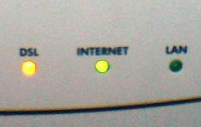Difference Between Broadband and DSL

In order to enjoy the amenities that are provided by the internet, users need a data link to connect; the faster the better. For an extended period of time, the world used dial-up connections via the widespread telephone system. This was very slow at a theoretical maximum of only 56kbps and a lot of people experimented on some solutions to solve this bottleneck. Broadband is the term used to refer to any technology that provided substantially faster connection speeds compared to dial-up. Direct Subscriber line, commonly known as DSL, is one of these technologies and it is one of the most popular technologies used in homes.
Broadband has opened up the internet to more than simple data. It allowed people to use the internet for listening to music, watching videos, and even sharing photos and other files. Peer to peer networks also started to appear after higher data speeds made it more feasible.
DSL is not the only technology that is capable of providing high speed access. There is ISDN, satellite internet, cellular broadband, and power-line internet to name a few. Each of these technologies has their own advantages and disadvantages that make them better for one application but not for another. DSL is widely preferred by a lot of homes and phone companies because they use the same infrastructure as standard telephone lines. It is easier for telephone companies because they don’t have to lay new lines. All it takes on the subscriber’s end is a line splitter/filter that separates the frequencies used for voice and the frequency used for data, and DSL modem. It also requires a lot less expense in terms of hardware compared to wireless technologies like cellular and satellite.
The definition of broadband has been evolving for as long as its existence. As of 2009, the FCC defines broadband as any internet technology that exceeds 768kbps. This excludes a lot of what we traditionally know as broadband. DSL has kept pace with the evolution of broadband internet and higher speeds are quite possible, as long as the provider is capable. Speeds of over 1mbps is quite commonplace and is even insufficient for a lot of users.
Summary:
1. Broadband is the umbrella terminology used for high speed internet access while DSL is only one of these technologies
2. There are other broadband technologies in use aside from DSL
3. DSL is advantageous compared to other broadband technologies as it can integrate to existing telephone systems
- Difference Between Sony Cybershot S Series and W Series - December 22, 2012
- Difference Between Samsung Galaxy S3 and iPhone 5 - December 21, 2012
- Difference Between Samsung Galaxy S2 (Galaxy S II) and Galaxy S 4G - December 20, 2012
